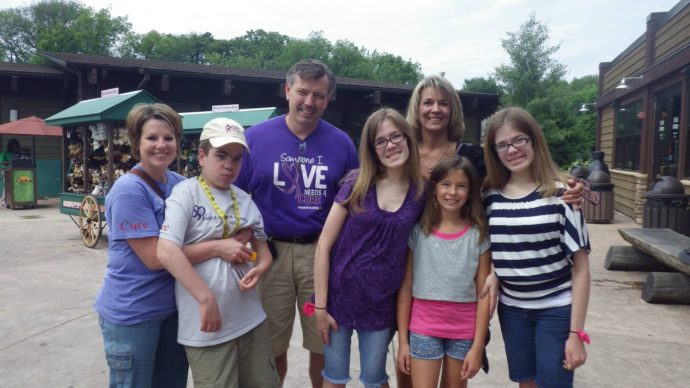The Quest To Find The Patients For Sanfilippo Syndrome Type D or MPS III D
For major diseases like diabetes, hypertension and cancer there are literally millions of patients, you probably know one or more person with one of these diseases, you may even have one of them. But when it comes to a rare disease like Sanfilippo syndrome (mucopolysaccharidosis type III; MPS III) you probably have never heard of it nor know of anyone with the disease. The same may also be said of the other 7000 or so other rare diseases. MPS III is a devastating neurodegenerative lysosomal storage disorder of childhood for which there is presently no cure or effective FDA approved treatment available. The cause of MPS III is an inherited mutation in one of the 4 enzymes required to catabolize heparan sulfate (HS), a glycosaminoglycan which plays important structural and functional roles in the brain and elsewhere. Each type of MPS III (A through D) is due to deficiency of a different enzyme in the HS breakdown pathway. The incidence of each type ranges from approximately 1:100,000 to 1:1,000,000. It has also been suggested that combined the four subtypes occur in 1:70,000 births.
 Heparan Sulfate
Heparan Sulfate
accumulates in lysosomes
and leads to neurological
symptoms of the disease.
For the last year Phoenix Nest (http://www.phoenixnestbiotech.com/) has been working with Dr. Patricia Dickson and her colleagues at the Los Angeles Biomedical Research Institute at Harbor-UCLA Medical Center to develop an enzyme replacement treatment (ERT) for MPS IIID that will ameliorate or reverse the catastrophic and fatal neurologic decline caused by this disease. As the symptoms of MPS III are largely localized to the brain any effective MPS III treatment must therefore gain access to the brain. Therefore, our strategy proposes to deliver the enzyme, recombinant human alpha-N-acetylglucosamine-6-sulfatase (rhGNS) intrathecally (into the spinal fluid) to effectively treat the underlying causes of the neurologic symptoms that dominate MPS III pathology. This is a delivery route which is widely used for other ERT’s. Dr. Dickson is also an expert in the mucopolysaccharidoses with specific expertise in the bench-to-bedside development of intrathecal enzyme replacement therapy.
We are in the process of writing a grant proposal to study this ERT in mice lacking the enzyme to see if it can rescue them from the ravages of the disease. After that it will be on to larger animal studies before getting FDA approval to go into the clinic. There are many things still to do, including scale up the production of enzyme and ensure that it is safe and efficacious in animals. But we need to find MPS IIID patients to get their support to make our case to the NIH and potentially anyone that would fund this work.
Meanwhile, Jonah’s Just Begun-Foundation to Cure Sanfilippo (JJB) has initiated the first Natural History Study for Sanfilippo syndrome type C and D with Dr. Paul Levy (as primary investigator) of the Children’s Hospital of Montefiore and with the support of the Lysosomal Disease Network part of the Rare Disease Clinical Research Network (RDCRN) funded consortium of institutions focused on rare diseases. Our Natural History Study will be a multi site longitudinal study for Sanfilippo syndrome type C and D and enrollment is scheduled for the fall of 2015. The purpose is to evaluate the course of disease progression in patients to identify potential surrogate endpoints that may be utilized in future clinical trials defined assessments including: standardized clinical, biochemical, neurocognitive, behavioral, developmental, and imaging measures.
Amazingly, we have reached this far on a very tight budget, but the cost of the next steps ramp up significantly. It will cost in the low millions of dollars to get to the clinic if we are lucky and everything goes to plan. We have scoured the literature to identify how many patients may exist. Several publications up to 2009 counted the number of case reports, suggested twenty one patients had been documented. An analysis of papers has identified: twelve new patients in the Netherlands, a patient each in Turkey, Poland, Pakistan, Australia and Saudi Arabia three patients in Italy and two patients in Belgium. Perhaps some of these are now sadly deceased. Yet we are also aware of two patients in the USA, two in Australia, one in the UK, France and Spain to date. Statistically there have to be more. Perhaps they have not been diagnosed, perhaps they are under the radar. We have reached out to MPS organizations, patient families and clinicians globally in our efforts. We would appreciate if anyone can help bring them to our attention or at the very least get them to sign up in the Sanfilippo patient registry (https://connect.patientcrossroads.org/?org=SanfilippoRegistry). We need these families to know that Phoenix Nest, as a patient family driven company are working on a treatment. We may be several years away from the clinic, but we have a team dedicated to this project. So please spread the word and help us find the families that are dealing with this disease.
*This blog was written by Sean Ekins. Sean is a scientist, and President, CEO, and Co-Founder of Phoenix Biotech, as well as trusted friend of JJB.


